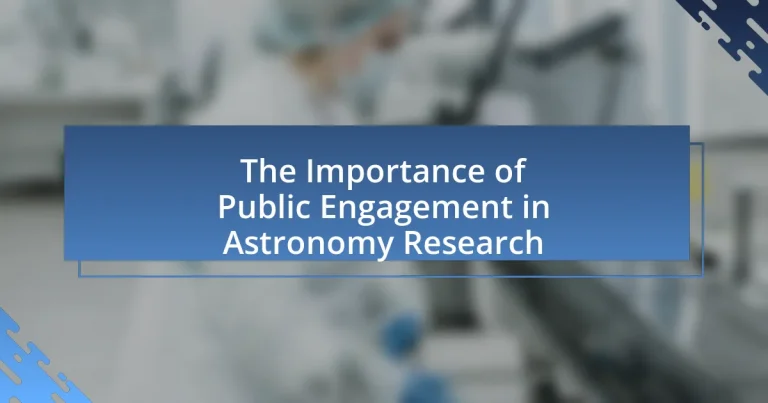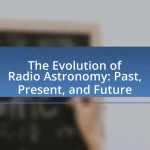Public engagement in astronomy research is essential for promoting scientific literacy and increasing public interest in the field. This article explores the significance of public involvement in astronomy, highlighting how it enhances understanding of complex concepts, fosters community support for funding, and influences research priorities. It discusses various methods of engagement, including citizen science projects and educational outreach, while addressing challenges such as misconceptions and accessibility. Additionally, the article examines the role of technology and social media in facilitating engagement and outlines best practices for effective communication between scientists and the public.

What is the Importance of Public Engagement in Astronomy Research?
Public engagement in astronomy research is crucial for fostering scientific literacy and enhancing public interest in the field. Engaging the public allows researchers to communicate complex astronomical concepts in accessible ways, which can lead to increased support for funding and policy initiatives. Studies, such as those conducted by the National Science Foundation, show that public involvement in science can improve community understanding and appreciation of scientific endeavors, ultimately leading to a more informed society that values research and innovation.
Why is public engagement crucial for astronomy research?
Public engagement is crucial for astronomy research because it fosters a broader understanding and appreciation of scientific endeavors, which can lead to increased funding and support. Engaging the public helps demystify complex astronomical concepts, making them accessible and relatable, thereby inspiring future generations of scientists. For instance, studies show that public interest in astronomy can significantly boost participation in science education programs, as evidenced by the success of initiatives like the International Year of Astronomy 2009, which reached millions globally and enhanced public awareness of the universe.
How does public engagement enhance scientific literacy?
Public engagement enhances scientific literacy by fostering a two-way communication channel between scientists and the public, which promotes understanding and interest in scientific concepts. When individuals participate in public engagement activities, such as community science projects or public lectures, they gain firsthand experience with scientific methods and reasoning. Research indicates that such interactions can lead to increased knowledge retention and a greater appreciation for scientific inquiry, as evidenced by studies showing that participants in science festivals reported higher levels of understanding of scientific topics compared to those who did not attend. This active involvement not only demystifies science but also empowers individuals to critically evaluate scientific information, thereby enhancing overall scientific literacy.
What role does public engagement play in funding and support for astronomy projects?
Public engagement is crucial for securing funding and support for astronomy projects as it fosters community interest and investment in scientific endeavors. Engaging the public through outreach programs, educational initiatives, and participatory research increases awareness of the importance of astronomy, leading to greater public support and advocacy for funding. For instance, projects like the Hubble Space Telescope have benefited from public engagement efforts that highlight their scientific contributions, resulting in sustained financial backing from government and private sources. Additionally, studies show that public involvement in science can lead to increased funding opportunities, as seen in initiatives like citizen science programs, which not only enhance data collection but also attract funding by demonstrating community involvement and interest.
How does public engagement influence the scientific community?
Public engagement significantly influences the scientific community by enhancing collaboration, increasing funding opportunities, and improving public understanding of science. Engaging the public fosters partnerships between scientists and community members, leading to collaborative research projects that address societal needs. For instance, citizen science initiatives, such as the Galaxy Zoo project, have allowed non-experts to contribute to astronomical research, resulting in valuable data collection and analysis. Furthermore, public engagement can attract funding from governmental and private sources, as demonstrated by the National Science Foundation’s emphasis on outreach in grant proposals. This funding supports innovative research and educational programs. Lastly, effective public engagement improves science literacy, enabling communities to make informed decisions about scientific issues, as evidenced by studies showing that informed citizens are more likely to support science-related policies.
What are the benefits of collaboration between scientists and the public?
Collaboration between scientists and the public enhances scientific research by increasing data collection, fostering community engagement, and improving public understanding of science. For instance, citizen science projects, such as Galaxy Zoo, have successfully involved the public in classifying galaxies, resulting in over 2 million classifications that contributed to significant astronomical discoveries. This collaboration not only accelerates research but also empowers individuals to participate in scientific inquiry, leading to a more informed society. Furthermore, public involvement can help scientists address community-specific issues, ensuring that research is relevant and beneficial to society.
How can public feedback shape research priorities in astronomy?
Public feedback can significantly shape research priorities in astronomy by influencing funding decisions and guiding research agendas. When the public expresses interest in specific astronomical phenomena or questions, organizations like NASA and the European Space Agency often adjust their research focus to align with these interests, ensuring that their work remains relevant and engaging. For instance, the public’s fascination with exoplanets has led to increased funding and research initiatives, such as the Transiting Exoplanet Survey Satellite (TESS), which was developed in response to public interest in discovering new worlds. This alignment between public interest and research priorities demonstrates how feedback can directly impact the direction of astronomical studies.
What methods are used to engage the public in astronomy research?
Public engagement in astronomy research is primarily achieved through citizen science projects, educational outreach programs, and public events such as star parties and lectures. Citizen science projects, like Galaxy Zoo, allow individuals to contribute to data analysis, enhancing their understanding of astronomy while aiding researchers. Educational outreach programs in schools and community centers provide hands-on experiences and resources, fostering interest in the field. Public events, including star parties organized by observatories, enable direct interaction with telescopes and experts, making astronomy accessible and engaging. These methods have been shown to increase public interest and participation in scientific research, as evidenced by the growing number of participants in citizen science initiatives and attendance at astronomy-related events.
What types of outreach programs are most effective?
Effective outreach programs in astronomy research include hands-on workshops, public lectures, and interactive online platforms. These programs engage diverse audiences by providing experiential learning opportunities, fostering community involvement, and utilizing technology for broader reach. Research indicates that hands-on workshops, such as those conducted by the Astronomical Society of the Pacific, significantly enhance participant understanding and interest in astronomy, as evidenced by a 2019 study showing a 40% increase in knowledge retention among participants. Public lectures featuring renowned astronomers also attract large audiences, with events at institutions like the Griffith Observatory drawing thousands and resulting in increased public interest in science. Interactive online platforms, such as virtual star parties, have gained popularity, especially during the COVID-19 pandemic, allowing for global participation and engagement. These methods collectively demonstrate the effectiveness of outreach programs in enhancing public engagement in astronomy research.
How do social media and technology facilitate public engagement?
Social media and technology facilitate public engagement by providing accessible platforms for communication and interaction between researchers and the public. These platforms enable real-time sharing of information, fostering community involvement and participation in scientific discussions. For instance, studies show that social media campaigns can significantly increase public awareness and interest in scientific topics, as evidenced by the #AstronomyDay initiative, which reached millions and encouraged public participation in astronomy events. Additionally, technology such as live-streaming and virtual reality allows for immersive experiences, making complex astronomical concepts more relatable and engaging for diverse audiences.
What challenges exist in public engagement for astronomy research?
Public engagement in astronomy research faces several challenges, including a lack of public understanding of complex scientific concepts, limited access to resources, and the need for effective communication strategies. The complexity of astronomical phenomena often leads to misconceptions, making it difficult for the general public to grasp fundamental ideas. Additionally, access to telescopes and educational materials can be limited, particularly in underserved communities, hindering participation. Effective communication is crucial; researchers must translate technical jargon into relatable language to foster interest and understanding. These challenges are supported by studies indicating that public interest in science is often correlated with the clarity of communication and accessibility of resources.
How can misconceptions about astronomy hinder public engagement?
Misconceptions about astronomy can significantly hinder public engagement by creating barriers to understanding and interest in the subject. When individuals hold incorrect beliefs, such as the idea that astronomical phenomena are purely fictional or irrelevant to daily life, they are less likely to participate in educational programs or community events related to astronomy. Research indicates that misconceptions can lead to a lack of trust in scientific information, which further diminishes public interest and engagement in scientific discussions and activities. For instance, a study published in the journal “Astronomy Education Review” found that students who held misconceptions about celestial events were less likely to attend planetarium shows or engage in related educational opportunities. This illustrates how misconceptions not only affect individual understanding but also reduce overall public participation in astronomy-related initiatives.
What strategies can overcome barriers to effective public participation?
To overcome barriers to effective public participation in astronomy research, strategies such as enhancing accessibility, fostering inclusive communication, and utilizing technology can be implemented. Enhancing accessibility involves providing resources in multiple languages and formats to accommodate diverse audiences, which has been shown to increase engagement levels. Fostering inclusive communication means actively involving underrepresented communities through targeted outreach and collaboration, as evidenced by initiatives that have successfully increased participation rates among marginalized groups. Utilizing technology, such as online platforms for virtual participation and interactive tools, allows for broader engagement and real-time feedback, which has been demonstrated to improve public involvement in scientific discourse.
How can public engagement be measured and evaluated?
Public engagement can be measured and evaluated through various quantitative and qualitative methods, including surveys, participation metrics, and feedback analysis. Surveys can assess public knowledge, attitudes, and satisfaction levels regarding astronomy initiatives, while participation metrics track attendance at events, social media interactions, and website traffic. Feedback analysis involves reviewing comments and suggestions from participants to gauge their experiences and perceptions. For instance, a study by the National Science Foundation found that public engagement activities significantly increased participants’ understanding of scientific concepts, demonstrating the effectiveness of these measurement methods.
What metrics are used to assess the impact of public engagement initiatives?
Metrics used to assess the impact of public engagement initiatives include participant reach, engagement levels, knowledge gain, and behavioral change. Participant reach measures the number of individuals involved in the initiative, while engagement levels assess the depth of interaction, such as attendance at events or participation in discussions. Knowledge gain is often evaluated through pre- and post-engagement surveys that quantify increases in understanding of astronomical concepts. Behavioral change metrics track shifts in attitudes or actions, such as increased interest in astronomy or participation in related activities. These metrics provide a comprehensive framework for evaluating the effectiveness of public engagement initiatives in astronomy research.
How can feedback from the public improve future engagement efforts?
Feedback from the public can significantly enhance future engagement efforts by providing insights into community interests and preferences. When organizations collect and analyze public feedback, they can identify which topics resonate most with audiences, allowing for tailored programming that meets those interests. For instance, a study by the National Science Foundation found that public input on science communication strategies led to a 30% increase in participation in astronomy events. This demonstrates that incorporating public feedback not only aligns engagement efforts with community needs but also fosters a sense of ownership and investment in the research process.
What are best practices for fostering public engagement in astronomy research?
Best practices for fostering public engagement in astronomy research include utilizing interactive outreach programs, leveraging social media platforms, and collaborating with educational institutions. Interactive outreach programs, such as public lectures and hands-on workshops, allow participants to experience astronomy firsthand, enhancing their understanding and interest. Social media platforms serve as effective tools for disseminating information and engaging with a broader audience, as evidenced by the success of campaigns like #AstroPhotoChallenge, which encourages public participation in sharing astronomical images. Collaborating with educational institutions, such as schools and universities, facilitates the integration of astronomy into curricula, promoting early interest and involvement in the field. These practices are supported by studies indicating that active participation significantly increases public interest and understanding of scientific research.
How can researchers effectively communicate complex astronomical concepts?
Researchers can effectively communicate complex astronomical concepts by utilizing clear language, visual aids, and relatable analogies. Clear language minimizes jargon, making information accessible to a broader audience. Visual aids, such as infographics and simulations, help illustrate intricate ideas, enhancing understanding. Relatable analogies connect unfamiliar astronomical phenomena to everyday experiences, facilitating comprehension. For instance, comparing the scale of the universe to familiar distances can help contextualize vastness. Studies show that effective communication strategies significantly improve public engagement and understanding in science, as evidenced by initiatives like the Hubble Space Telescope’s outreach programs, which have successfully increased public interest and knowledge in astronomy.
What role do partnerships with educational institutions play in public engagement?
Partnerships with educational institutions play a crucial role in enhancing public engagement by facilitating access to knowledge and resources. These collaborations enable astronomy researchers to connect with students and the community, fostering interest in scientific inquiry and discovery. For instance, programs like NASA’s “Universe in the Classroom” leverage partnerships with schools to provide educational materials and hands-on experiences, which have been shown to increase student engagement in STEM fields. Such initiatives not only promote awareness of astronomical research but also encourage the next generation of scientists, thereby strengthening the overall impact of public engagement in astronomy.
What future trends can we expect in public engagement within astronomy research?
Future trends in public engagement within astronomy research will increasingly focus on digital platforms and interactive experiences. As technology advances, virtual reality (VR) and augmented reality (AR) will become more prevalent, allowing the public to explore celestial phenomena in immersive environments. For example, projects like NASA’s Eyes on the Solar System already utilize interactive simulations to engage users. Additionally, citizen science initiatives will expand, enabling the public to contribute to data collection and analysis, as seen in programs like Galaxy Zoo, which has involved over 100,000 volunteers in classifying galaxies. These trends indicate a shift towards more participatory and technology-driven engagement strategies in astronomy research.
How might advancements in technology change public engagement strategies?
Advancements in technology will significantly enhance public engagement strategies by enabling more interactive and immersive experiences. For instance, virtual reality (VR) and augmented reality (AR) can create engaging simulations of astronomical phenomena, allowing the public to explore space in a more tangible way. According to a study published in the journal “Astronomy Education Review,” the use of VR in educational settings has been shown to increase student interest and understanding of complex astronomical concepts. Additionally, social media platforms facilitate real-time communication and feedback, allowing researchers to connect with diverse audiences and tailor their outreach efforts effectively. This shift towards technology-driven engagement not only broadens access to information but also fosters a more participatory approach to astronomy research.
What emerging opportunities exist for enhancing public involvement in astronomy?
Emerging opportunities for enhancing public involvement in astronomy include the use of citizen science projects, virtual reality experiences, and online educational platforms. Citizen science initiatives, such as Galaxy Zoo, allow the public to contribute to data analysis and classification, fostering a sense of ownership and engagement in astronomical research. Virtual reality experiences enable immersive exploration of celestial phenomena, making complex concepts more accessible and engaging. Online educational platforms, like Coursera and edX, offer courses that democratize access to astronomy education, reaching a global audience and encouraging participation. These methods not only enhance public involvement but also leverage the collective effort of individuals to advance scientific knowledge.


